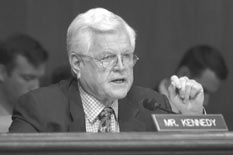Untitled Document
 |
Sen. Edward Kennedy (D-Mass.):
Blasting the Bush Administration over GAO decision. |
The investigative arm of Congress has found that parts of a Bush administration
video explaining changes to Medicare violate the government ban on publicity
and propaganda.
In its decision released yesterday, the General Accounting Office (GAO)
said that the Centers for Medicare and Medicaid Services (CMS), the agency that
oversaw the production of the videos, had illegally used appropriated funds
to make the “video news releases,” or VNRs.
The segment of the releases that violated the law was a short news report, intended
to be broadcast by local television stations, and an accompanying script for
anchors to use as a lead-in. Nowhere in the report did the narrator disclose
that it was written and filmed by CMS.
“Neither the story packages nor scripts identified [the Department of
Health and Human Services (HHS)] or CMS as the source … and the content
of the news reports was attributed to individuals purporting to be reporters,
but actually hired by an HHS subcontractor,” wrote Anthony Gamboa, GAO
general counsel.
Democrats on Capitol Hill seized quickly on GAO’s findings, calling the
administration dishonest and deceptive.
Bill Pierce, an HHS spokesman, said the administration disagreed with GAO’s
report.
“Each of those segments were separated into video and audio tracks. We
left it there for producers to decide…” Pierce said. “They
could have stripped out sound and put in voiceover, they could have put a voiceover
in providing attribution. That’s why we produced it the way we did.”
Forty stations used the videos, Pierce said, but the administration did not
have any information about which parts of the tapes they used.
He also pointed out that HHS produced similar videos during the Clinton administration
that did not separate audio and video tracks and also did not include the extra
footage, known as b-roll. This, Pierce said, forced “producers to either
take it or leave it.”
Pierce stressed that the GAO ruling did not prohibit the production of VNRs
because it only found fault with one of the three parts of the video. Under
Secretary Tommy Thompson, HHS has produced video news releases for its anti-obesity
and anti-bullying campaigns.
The other segments of the video—which included footage of the lawmakers
with the president as he signed the law, shots of senior citizens in doctors
offices and pharmacies, and an explanation of the new law by HHS officials—were
deemed acceptable by GAO because they were only intended to be used by news
organizations in their own reports.
The news stories were produced by Home Front Communications as a subcontractor
to Ketchum, Inc., which had contracted with HHS to help spread information regarding
the new law.
Earlier this year, GAO concluded that flyers and advertisements produced by
HHS about the Medicare Prescription Drug, Improvement and Modernization Act
did not violate the law. Several Democratic members of Congress had complained
that the materials were propaganda meant to convince Americans that the changes
to Medicare would greatly benefit them.
Lawmakers who were disappointed by the earlier ruling quickly used today’s
decision to criticize the administration.
“The new GAO opinion is yet another indictment of the deception and dishonesty
that has become business as usual for the Bush Administration,” said Sen.
Edward Kennedy (D-Mass.) in a statement. “It was bad enough to conceal
the cost of the Medicare drug bill from the Congress and the American people.
It is worse to use Medicare funds for illegal propaganda to try to turn this
lemon of a bill into lemonade for the Bush campaign.”
Rep. Pete Stark (D-Calif.), ranking Democrat on the House Ways and Means health
subcommittee, called on television stations that used the footage to retract
their reports.
“TV news stations that aired the VNRs have a journalistic responsibility
to set the record straight,” he said in a statement. “If the government
is allowed to get away with disseminating this sort of propaganda, the democratic
tradition of a free and independent media is threatened.”
In its defense, CMS had argued that the source of the videos had been clearly
identified to news organizations who got them from the distributor. But the
actual footage did not identify CMS and concluded with the narrator saying “In
Washington, I’m Karen Ryan reporting.”
VNRs are standard practice in the public-relations industry and local news
reports often rely on them, sometimes merely for background images and other
times for full reports. However, GAO said in its decision, “our analysis
of the proper use of appropriated funds is not based upon the norms in the public
relations and media industry.”
The investigators said they used three general criteria to decide the legality
of the materials: whether they are “self aggrandizing, purely partisan
in nature, or covert as to source.” The report concluded that the story
segments of the VNR were “covert” because they could be misleading
to the audience, which might think they were produced by a news organization.

